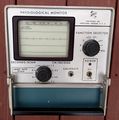Physiological Monitor: Difference between revisions
No edit summary |
No edit summary |
||
| Line 1: | Line 1: | ||
The Tektronix Physiological Monitor might have been a prototype of what became the [[410]]. | The '''Tektronix Physiological Monitor''' might have been a prototype of what became the [[410]]. | ||
It is all solid-state except for the CRT. | It is all solid-state except for the CRT. | ||
It has a nickel-cadmium battery pack comprising 10 D-size cells. | It has a nickel-cadmium battery pack comprising 10 D-size cells. | ||
The battery is center-tapped, providing +6. | The battery is center-tapped, providing +6.25 V and -6.25 V when fully charged. | ||
There doesn't appear to be any sort of regulator or DC-to-DC converter | There doesn't appear to be any sort of regulator or DC-to-DC converter | ||
for the low voltage, just direct connection of the battery to the amplifiers and other circuitry. | for the low voltage, just direct connection of the battery to the amplifiers and other circuitry. | ||
Latest revision as of 12:42, 12 April 2024
The Tektronix Physiological Monitor might have been a prototype of what became the 410. It is all solid-state except for the CRT.
It has a nickel-cadmium battery pack comprising 10 D-size cells. The battery is center-tapped, providing +6.25 V and -6.25 V when fully charged. There doesn't appear to be any sort of regulator or DC-to-DC converter for the low voltage, just direct connection of the battery to the amplifiers and other circuitry. There is a power oscillator generating the high voltage for the CRT.
Links
Photos
-
Front
-
Front
-
With Tek 222 for size reference
-
With Tek 222 for size reference
-
Profile
-
Top internal
-
Right internal
-
Left internal
-
Bottom internal
-
Rear
-
Battery right internal
-
Battery right internal
-
Battery connector
-
Battery bottom internal
-
Battery top internal













